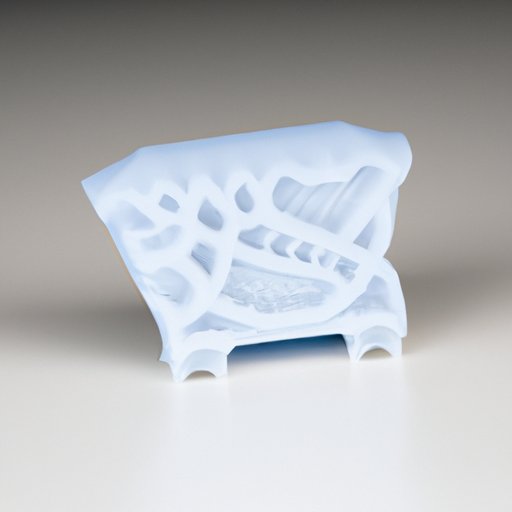Introduction
3D printing technology is a revolutionary new way to manufacture products and parts. It has the potential to revolutionize the manufacturing industry and change the way we think about production. In this article, we’ll explore what 3D printing technology is and how it works, as well as the potential applications and benefits it offers to manufacturers.

Section 1: A Comprehensive Guide to 3D Printing Technology
Before we can explore the potential of 3D printing technology, let’s take a look at what it is and how it works.
A. What is 3D Printing?
3D printing, also known as additive manufacturing, is a process of creating three-dimensional objects from a digital model. Instead of using traditional manufacturing techniques such as cutting or molding, 3D printing uses an additive process in which successive layers of material are laid down in order to build up the desired object. This process eliminates the need for expensive tooling and allows for highly customized designs.
B. How Does 3D Printing Work?
The 3D printing process starts with a 3D model that is created using computer-aided design (CAD) software. This model is then converted into a format that is readable by the 3D printer. The printer then reads the instructions and begins to build the object layer by layer. Depending on the type of 3D printing technology being used, the layers may be made of plastic, metal, or even living cells.
C. Types of 3D Printing Technologies
There are several different types of 3D printing technologies available. The most common types are Fused Deposition Modeling (FDM), Selective Laser Sintering (SLS), and Stereolithography (SLA). Each type of 3D printing technology has its own advantages and disadvantages, so it’s important to do your research before selecting a technology for your application.

Section 2: Exploring the Potential of 3D Printing Technology
Now that we’ve taken a look at what 3D printing is and how it works, let’s explore the potential of this technology and how it is changing the manufacturing industry.
A. How 3D Printing is Revolutionizing Manufacturing
3D printing has the potential to revolutionize the way products are manufactured. According to a recent study by McKinsey & Company, “3D printing could reduce the lead time for producing some products by up to 90 percent and cut cost by up to 75 percent.” This reduction in lead time and cost would enable manufacturers to produce more complex and customized products faster and cheaper than ever before.
B. The Benefits and Challenges of 3D Printing
Though 3D printing offers numerous benefits, there are still some challenges that need to be addressed. Currently, 3D printing is limited by the materials that can be used and the size of the objects that can be printed. Additionally, the cost of 3D printers and materials can be prohibitive for some manufacturers. Despite these challenges, the potential for 3D printing is enormous and the technology is continuing to evolve and become more accessible.

Section 3: An Introduction to 3D Printing Materials
In order to understand the potential of 3D printing, let’s take a look at the materials that are commonly used in 3D printing.
A. Commonly Used 3D Printing Materials
3D printing materials range from plastics and metals to living cells. Some of the most common materials used in 3D printing include ABS plastic, PLA plastic, nylon, and polycarbonate. Each material has its own advantages and disadvantages, so it’s important to choose the right material for your application.
B. Advantages and Disadvantages of Different 3D Printing Materials
ABS plastic is one of the most commonly used 3D printing materials. It is strong, durable, and relatively inexpensive. However, it is not biodegradable and can emit toxic fumes when heated. PLA plastic is another popular 3D printing material. It is made from renewable sources and is biodegradable. However, it is not as strong or durable as ABS plastic. Nylon is a strong, flexible material that is often used for functional parts. It is more expensive than other 3D printing materials, but it is very durable. Polycarbonate is an extremely strong and heat-resistant material that is often used for engineering applications. It is more expensive than other 3D printing materials, but it offers superior performance.
Section 4: A Look at the Future of 3D Printing Technology
Now that we’ve taken a look at the current state of 3D printing technology, let’s explore the future of this technology and its potential applications.
A. Trends in 3D Printing Technology
3D printing technology is continuing to evolve and become more accessible. As 3D printing technology becomes more widespread, the cost of 3D printers and materials continues to decrease, while the quality and accuracy of the prints continue to improve. Additionally, new materials are being developed that will allow for even more complex and specialized prints.
B. Potential Applications for 3D Printing
The potential applications for 3D printing are virtually limitless. 3D printing can be used for rapid prototyping, custom medical implants, and even food production. Moreover, 3D printing can be used to create complex structures that were previously impossible to manufacture. According to a recent report by Gartner, “3D printing will be used to manufacture everything from aircraft engines to entire buildings.”
Conclusion
3D printing technology is revolutionizing the manufacturing industry and changing the way products are produced. By eliminating the need for expensive tooling, 3D printing enables manufacturers to quickly and cheaply produce highly customized products. Additionally, new materials and technologies are being developed that will allow for even more complex and specialized prints. With its endless potential applications, 3D printing is sure to have a major impact on the manufacturing industry in the years to come.
(Note: Is this article not meeting your expectations? Do you have knowledge or insights to share? Unlock new opportunities and expand your reach by joining our authors team. Click Registration to join us and share your expertise with our readers.)
